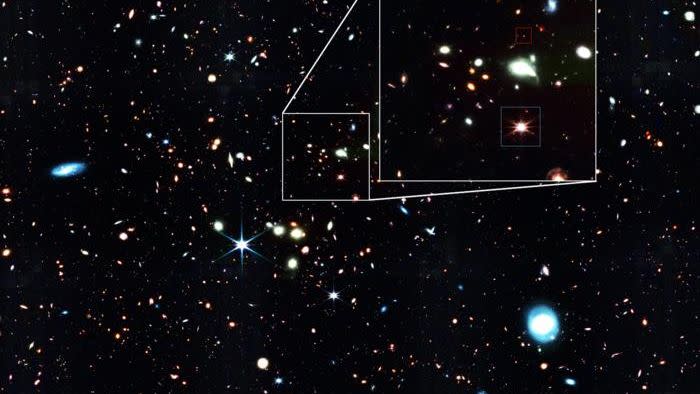JWST Found Baby Quasars. They Could Help Solve An Astronomical Mystery.

A new study uses spectroscopy to separate and study baby quasars.
Quasars are supermassive black holes that have absorbed enormous brightness.
Colors representing gases help researchers distinguish baby quasars from the adult quasars.
In new research using the James Webb Space Telescope (JWST), published in The Astrophysical Journal, a large team of scientists showed that they were able to isolate and scrutinize a bunch of tiny red dots we used to think were normal galaxies. That might not sound like much on the surface, but it turns out that those galaxies could actually be home to very young quasars—the term for black holes that suck up surrounding astronomical bodies until they become some of the brightest objects in the entire universe.
Quasars are old news, but they’re not well understood, and these baby quasars could help to solve one of astronomy’s biggest open questions. In an ISTA statement about the new paper, Jorryt Matthee—astrophysicist at the Institute of Science and Technology Austria (ISTA) and lead author of the new study—summarizes why supermassive black holes that become quasars are such a puzzle for scientists. “It’s like looking at a five-year-old child that is two meters tall,” he explains. “Something doesn’t add up.”
Basically, they’re too big for the age of our universe.
The cosmic scale of time is long, and supermassive black holes can be thousands of light years across. Quasars, though, are on the small end of the supermassive black hole size class—sometimes just a few days across, or about 1,000 of the distance between Earth and the Sun, Space.com explains. Even so, the events that lead to the formation of quasars can take billions of years, similar to the predicted 6-billion-year timeline for the full merger of the Milky Way and Andromeda, the closest large spiral galaxy to our neck of the intergalactic woods.
The oldest visible quasar is over 13 billion years old, which means it needed to already be a supermassive black hole when the universe was very, very young—at least, according to our current understanding of how quasars form. But just after the Big Bang, the universe was significantly different from how it is today. It hosted a much simpler selection of elements and much larger and more spectacular phenomena on the menu.
As a result, scientists have theorized that supermassive black holes might have formed more quickly with a physics-boosted head start from swirls of gas and clouds that we no longer observe in the universe. It’d be like giving that five-year-old child the super-soldier serum from Captain America—of course he’s going to be uncommonly tall. He got a big leg up.
In this new study, the researchers examined those faint red dots spotted on imagery from JWST and found that the baby quasars were reddened by dust, something that goes hand in hand with galaxy and star formation. This cosmic dust is made of vital materials and is more like an Instant Celestial Object Kit—not the lint and cat hair under the couch. Those little guys fill in a crucial missing link in the quasar-life-cycle chain, and should allow astronomers to better understand how these oddballs form. To even further extend Matthee’s “giant-five-year-old” metaphor, these are the two-year-olds that are already a little bigger than they really should be.
The redness itself also helps scientists date the baby quasars to an earlier age than the bluer, older quasars that have cleared their dust. Additionally, it positions them as emerging from the swirling star nurseries that don’t register as red in this view.
The JWST is not a specialized instrument for detecting space objects of this type, which means the researchers were pleasantly surprised by the work they were able to do without needing something more tuned to this particular task. The telescope’s NIRCam instrument turned out to be just enough, as its spectroscopy mode lets scientists tune to specific areas of the spectrum using a focus object called a grism (prism plus grate).
From there, they can look at only what is red, for example, like using the red lenses that reveal blue answers in some retro games. Even more baby quasars could be just a color shift away.
You Might Also Like


